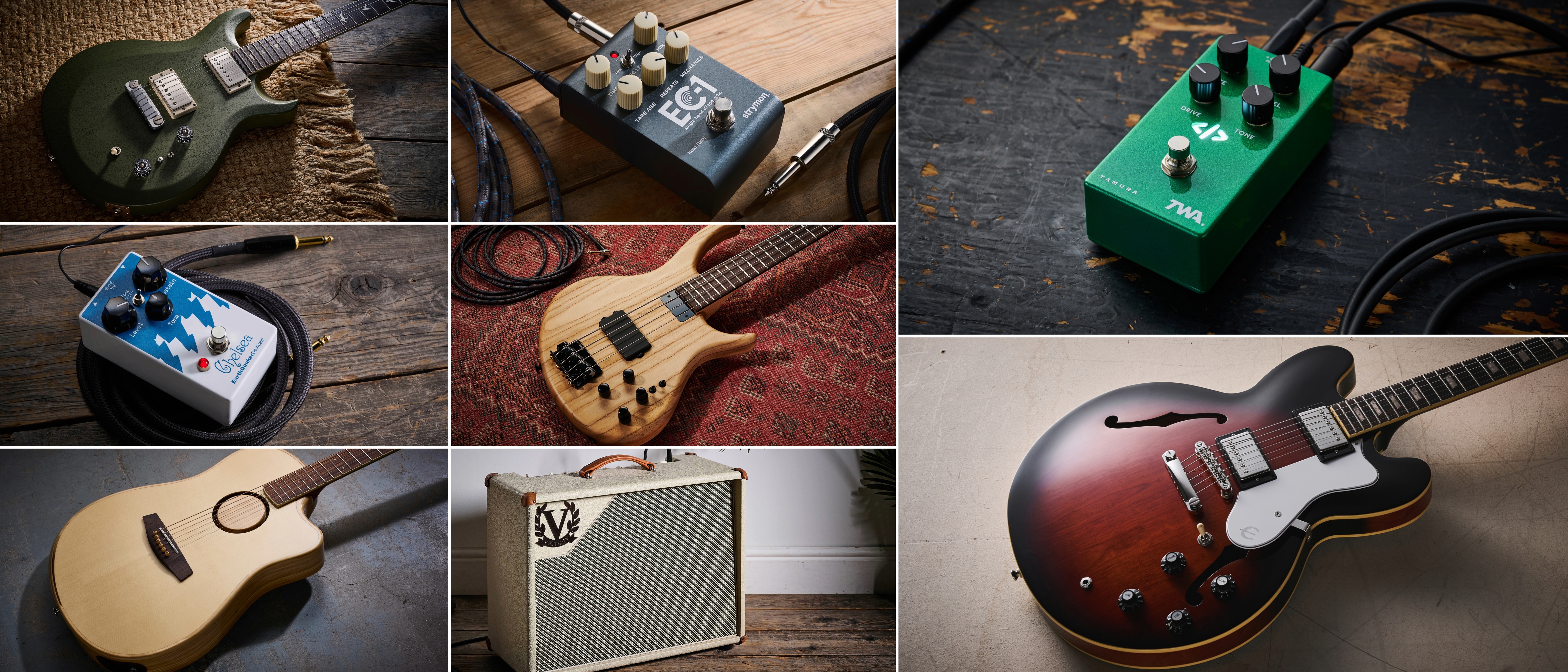Constant Motion: 10 incredible John Petrucci guitar performances
To celebrate the release of Dream Theater’s new album, A View From the Top of the World, Guitar World looks at some of Petrucci’s best and brightest guitar moments

If there’s a reason progressive rock guitar playing has any sort of cache or, to be honest, continued life in 2021, it’s arguably due to the existence of John Petrucci.
Sure, guitarists always have (and likely always will) love to shred. And there’s certainly no lack of wild, over-the-top six- (and seven-, and eight-) string gymnastics happening every day on records, stages, and in 30-second clips on Instagram and YouTube.
But when it comes to true progressive rock, with all of the elements fans love about it and critics often deride it for – epic song structures; knotty, extremely technical arrangements; odd time signatures; wild tempo shifts; grandiose ideas; and, of course, ridiculously agile and accomplished playing – there’s not a single band that has flown that flag as gloriously, unabashedly or successfully as Dream Theater has for the past 30-odd years.
Likewise, during that time Petrucci has emerged as a true guitar hero. Whether with Dream Theater, Liquid Tension Experiment or in his own solo work, he continues to inspire fans and generations of players alike with not his only insane chops and creativity, but also his dedication to his instrument, as well as his commitment to exploring the outermost limits of guitar technique and, in his collaborations with Ernie Ball, guitar design.
With that in mind, and in celebration of the release of Dream Theater’s new and 15th album, A View From the Top of the World, Guitar World looks at some of the greatest musical moments from Petrucci’s unmatched career.
Under a Glass Moon (1992)
Dream Theater’s second album, Images and Words, was also their mainstream breakthrough, featuring their one and, to this day, only “hit” single, “Pull Me Under.” But while that track is the one that most casual Dream Theater fans remember, “Under the Glass Moon” has long been a true fan favorite, primarily for Petrucci’s mid-song solo, which many rank as among his best. From the screaming doublestop that announces its entrance, to the inventive harmonics work, wild whammy squiggles and squeals and all-out-shredding, it’s a breathless ride from start to finish.
And then there’s the truly awesome high-to-low note sweeps, which Petrucci once explained to Guitar World: “I focus on two elements to make those sound good. First, I really separate the notes with my fretting hand so they don’t ring out like a chord. Second, I drag the pick from one string to the next using the hand’s momentum. That way I’m not actually picking the individual strings but rather pulling the pick up against the string.” Sounds simple enough, no?
The Dance of Eternity (1999)
Given Dream Theater’s commitment to making some of the most progressive music of the past 30-plus years, it’s hard to believe that Metropolis Pt. 2: Scenes from a Memory, their fifth album overall, was actually their first concept record. And yet, that’s also what makes it one of their most beloved, with the band fully indulging their proggiest of tendencies. And nowhere is that more evident than on the album's sole instrument, “The Dance of Eternity.”
More an ensemble piece than a platform for soloing, the six-minute tune is said to feature more than 100 (!) time signature changes, and runs the gamut from metal to prog to fusion to bizarro-world ragtime to almost cartoonish passages. It’s fierce, furious, technically insane, mentally exhausting and at times whimsical in a way that Dream Theater isn't known for. An expertly composed and performed piece that demonstrates Petrucci’s adeptness at being a consummate teammate and supporting player.
The Glass Prison (2002)
The opening track on 2002’s Six Degrees of Inner Turbulence, “The Glass Prison” starts on a lighter note… but it doesn’t stay there for long. Over the course of most of its 13-plus minutes it’s a grinding, galloping beast fueled by Portnoy’s intense double-bass drumming and Petrucci’s wah-drenched rhythm guitar. Portnoy once described the track, also the first song in the band’s “Twelve-step Suite,” as “this total Pantera-meets-Megadeth, relentless ball of energy.” Which certainly tracks. Although it’s up to the listener to determine if either of those bands ever committed to tape a solo as utterly ferocious as the one Petrucci lays down here.
Constant Motion (2007)
2007’s Systematic Chaos was one of Dream Theater’s heaviest offerings, a fact borne out by the album’s leadoff single, “Constant Motion,” which is propelled forward by a positively nasty Petrucci syncopated groove-metal riff and accented by growled vocals from LaBrie.
But if the verses and chorus resemble nothing so much as Metallica, the middle section is pure Dream Theater. Where the earlier guitar parts were crushing and claustrophobic, Petrucci’s solo is stately and fluid. He wraps up the proceedings with some nimble note flutters and heavens-ascending whammy work that mimic a flock of birds taking flight. And then the throttling recommences…
The Count of Tuscany (2009)
One of Dream Theater’s longest songs to date – and that’s saying something with this band – “The Count of Tuscany” runs for more than 19 minutes and plays like an entire musical in and of itself. The first section, which spans roughly three-and-a-half minutes, comes on like the opening theme to the coolest prog-rock Broadway show you’ve never seen. Then things get heavy and wild… until they don’t. More than 10 minutes in, Petrucci embarks on a long, impressionistic solo section where his guitar takes on wraithlike violin tones over atmospheric keyboard pads. From there, he ventures into an uncharacteristically pastoral section anchored by his acoustic guitar strumming, before ending the song with a climactic and positively majestic solo section.
“That chord progression at the end of ‘The Count of Tuscany’ indicates a big-time Rush influence,” he told Guitar World. “They have always had the ability to write majestic-sounding music – very royal and uplifting. That chord progression evokes a moving and positive end to the story.”
Breaking All Illusions (2011)
Following an opening harmony guitar salvo that comes off as a brighter-toned take on Iron Maiden’s twin-axe approach, “Breaking All Illusions” settles into something resembling a standard Dream Theater song – if such a thing even exists – with plenty of twisting, turning high-energy passages dominated by Petrucci’s guitar and Rudess’ keys. But roughly seven minutes in, Petrucci pulls off something entirely different for his style – an out-and-out blues-rock solo. Both subtle and shredding, Petrucci’s lines and phrases are positively spellbinding, characterized by some of his most vocal-like playing.
“It starts out kind of bluesy, then it’s kind of jazzy, and it builds and builds,” Petrucci told MusicRadar about the solo. “I got a chance to use so many aspects of guitar playing: phrasing and melodic elements, blues, jazz, shred. It was very satisfying to record.” How’s that for a dramatic turn of events?
Pale Blue Dot (2019)
Petrucci himself once characterized “Pale Blue Dot” as having some “wacky, super-fast things,” going on in it, and, well, we’d agree. One of the standout tracks from 2019’s Distance over Time, “Pale Blue Dot” closes the album with an extended solo section of pure instrumental freakout, with Petrucci’s guitar ping-ponging around the arrangement, bouncing off of and reacting to all the changing tempos and rhythms. At times it sounds Zappa-esque, at others like the soundtrack to a Looney Tunes episode. All you can do is hold on and enjoy the ride.
Terminal Velocity (solo, 2020)
It had been 15 years since a Petrucci solo effort when Terminal Velocity was unleashed on the world. And the guitarist didn’t disappoint. In addition to reuniting with ex-Dream Theater drummer Portnoy for the effort, he kicked things off in grand fashion with the incendiary title track, which opens with an absolutely soaring, major-key guitar figure that comes off like a futuristic Yes, before breaking into a full-on pop-rock shred extravaganza.
Petrucci recalled to Guitar World that the excessively hooky and melodic track was the first he wrote for the record: “It was one of those seeds that I had in my files that jumped out at me as soon as I went back and heard it. I started playing the main lick and it developed right away into something cool. It’s done backwards with filtering so it gives you this really textured sound.
He continued, “That riff just sounded like an album opener to me, and it remained the album opener because there was something about it that caught my attention right away.“
The Passage of Time (Liquid Tension Experiment, 2021)
For those who desire to hear Petrucci in pure, full-on prog instrumental mode (and really, who doesn’t?), Liquid Tension Experiment is always a solid bet. Which made it all the more of an event when the Petrucci-Mike Portnoy-Tony Levin-Jordan Rudess supergroup announced its first album in more than 20 years, LTE3. And even with the, um, passage of time, the leadoff single “The Passage of Time” delivered on everything you want and expect from Petrucci, with rollercoaster riffing and smooth-as -glass soloing.
Recalled Petrucci about the track, “This was the first song we worked on and when it was done, we all knew once again how amazing it was to be working together. We knew we were on to something and that this was going to be a really amazing album.” Liquid, indeed.
Awaken the Master (2021)
“Awaken the Master” is one of the heaviest tracks on Dream Theater’s newest album, A View From the Top of the World, and that’s hardly a surprise, given it also marks the very first instance of Petrucci using his newly-developed eight-string Ernie Ball Majesty signature guitar.
To be sure, he puts the Majesty to expert use, unleashing grinding, guttural riffs and growls out of the eight-stringer, and traversing the instrument’s entire range, from ultra-low-register rhythms to soaring guitar solos.
Explaining his approach on the song, Petrucci told Guitar World: “That extra string broadened the range of the instrument. Think of it as a keyboard player having more keys so he can go lower – that’s what it’s like with this guitar. Things like scales and arpeggios translate beautifully because their shapes stay the same; I don’t use any sort of weird tuning.
“With chords, you have to adjust and figure out how that added range is going to extend, but that came pretty quickly. There was a bit of learning how to work the sound a bit, but it’s been so much fun.”
It’s an impressive and innovative display, and one that shows Petrucci, more than 30 years in, still exploring and pushing the limits of his seemingly boundless style.
All the latest guitar news, interviews, lessons, reviews, deals and more, direct to your inbox!
Since 1980, Guitar World has been the ultimate resource for guitarists. Whether you want to learn the techniques employed by your guitar heroes, read about their latest projects or simply need to know which guitar is the right one to buy, Guitar World is the place to look.

